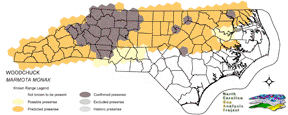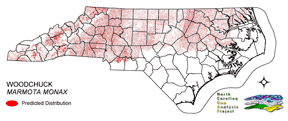
| Taxa: |
| Order: |
| Family: |
| Mammalia |
| Rodentia |
| Sciuridae |
| NatureServe Global Rank: |
| NatureServe State (NC) Rank: |
| G5 |
| S5 |
| Federal Status: |
| NC State Status: |
| --- |
| --- |


| Land Unit |
| US Fish & Wildlife Service |
| US Forest Service |
| US National Park Service |
| US Department of Defense |
| NC State Parks |
| NC University System |
| NC Wildlife Res. Com. |
| NC Forest Service |
| NC Div. of Coastal Mgmt. |
| Local Governments |
| Non-Governmental Org. |
| Other Public Lands |
| Private Lands |
| GAP Status 1-2 |
| All Protected Lands |
| Statewide |
| Hectares |
| 225.27 |
| 17,651.43 |
| 539.01 |
| 3,141.81 |
| 2,977.47 |
| 185.94 |
| 4,125.24 |
| 260.64 |
| 0.00 |
| 565.38 |
| 782.91 |
| 1,040.40 |
| 1,528,190.55 |
| 11,420.73 |
| 30,949.29 |
| 1,559,686.05 |
| Acres |
| 556.65 |
| 43,617.62 |
| 1,331.92 |
| 7,763.58 |
| 7,357.49 |
| 459.47 |
| 10,193.69 |
| 911.37 |
| 0.00 |
| 1,397.08 |
| 1,934.61 |
| 2,570.88 |
| 3,776,240.35 |
| 28,488.55 |
| 76,744.66 |
| 3,854,334.73 |
| % of Dist. on |
| Prot. Lands |
| 0.7 % |
| 57.0 % |
| 1.5 % |
| 10.2 % |
| 9.6 % |
| 0.6 % |
| 12.9 % |
| 0.8 % |
| 0.0 % |
| 2.4 % |
| 2.4 % |
| 2.4 % |
| 0.0 % |
| 36.9 % |
| ----- |
| ----- |
| % of Dist. on |
| All Lands |
| < 0.1 % |
| 1.1 % |
| < 0.1 % |
| 0.2 % |
| 0.2 % |
| < 0.1 % |
| 0.3 % |
| < 0.1 % |
| 0.0 % |
| < 0.1 % |
| < 0.1 % |
| < 0.1 % |
| 98.0 % |
| 0.7 % |
| ----- |
| ----- |
|
NATURE SERVE GLOBAL HABITAT COMMENTS: Prefers open areas, such as meadows, pastures, old fields, orchards. Also may use hedgerows, open woodlands, brushy areas. May hibernate in burrow in wooded area. Hilly and rocky areas in open woodlands having fields or meadows adjacent (Caire et al. 1989). In Connecticut, burrow systems were often along woodland edges and brushy fence rows (Swihart 1992). Young are born in a den in an extensive burrow system. |
| Code | Name | Description | NC Natural Heritage Program Equivalent |
| 226 | Piedmont Xeric Woodlands | Generally post and blackjack oak dominated woodlands. White ash and pignut hickory can be found in combination with Eastern red cedar on glades. | Xeric Hardpan Forest |
| 20 | Coniferous Regeneration | Regenerating pine stands. Predominantly loblolly pine, but slash and longleaf stands occur as well. | No equivalent |
| 36 | Successional Deciduous Forests | Regenerating deciduous trees with a shrub stature. Commonly dominated by sweetgum, tulip poplars and maples. | No equivalent |
| 205 | Agricultural Pasture/Hay and Natural Herbaceous | Farm fields used for pasture grass or hay production, as well as old fields dominated by native and exotic grasses. | No equivalent |
|
Lee, D. S., and J. B. Funderburg. 1982. Marmots. Marmota monax and allies. Pages 176-191 in Chapman, J. A., and G. A. Feldhamer, editors. Wild mammals of North America. Biology, management, economics. Johns Hopkins Univ. Press.
Howell, A. H. 1915. Revision of the North American marmots. North American Fauna 37:1-80. Jones, J. K., Jr., et al. 1992. Revised checklist of North American mammals north of Mexico, 1991. Occas. Pap. Mus., Texas Tech Univ. (146):1-23. Swihart, R. K. 1992. Home-range attributes and spatial structure of woodchuck populations. J. Mamm. 73:604-618. Wilson, D. E., and D. M. Reeder (editors). 1993. Mammal Species of the World:a Taxonomic and Geographic Reference. Second Edition. Smithsonian Institution Press, Washington, DC. xviii + 1206 pp. Grizzell, R.A. 1955. A study of the southern woodchuck, Marmota monax monax. Am. Midl. Nat. 53(2):257-293. Banfield, A.W.F. 1974. The mammals of Canada. University of Toronto Press, Toronto. Godin, A.J. 1977. Wild Mammals of New England. Johns Hopkins University Press, Baltimore. 304 pp. Hamilton, William J., Jr., and John O. Whitaker, Jr. 1979. Mammals of the eastern United States. Cornell Univ. Press, Ithaca, New York. 346 pp. Hall, E. R. 1981. The Mammals of North America. Second edition. 2 Volumes. John Wiley and Sons, New York, New York. Schwartz, Charles W., and Elizabeth R. Schwartz. 1981. The wild mammals of Missouri. University of Missouri Press, Columbia. 356 pp. Baker, Rollin H. 1983. Michigan mammals. Michigan State University Press. 642 pp. Koprowski, J. L. 1987. Nocturnal activity of the woodchuck, MARMOTA MONAX, in an urban park in Ohio. Canadian Field-Nat. 101:606-607. Barash, D. P. 1989. Marmots:social behavior and ecology. Stanford Univ. Press, Stanford, California. xvii + 360 pp. Caire, W., J. D. Tyler, B. P. Glass, and M. A. Mares. Z. Marsh (illustrator). 1989. Mammals of Oklahoma. University of Oklahoma Press, Norman. Oklahoma. 567 pp. Dolbeer, R. A., et al. 1991. Efficacy of two gas cartridge formulations in killing woodchucks in burrows. Wildl. Soc. Bull. 19:200-204. Swihart, R. K., and M. R. Conover. 1991. Responses of woodchucks to potential garden crop repellents. J. Wildl. Manage. 55:177-181. |
For more information please contact them at:
NC-GAP Analysis Project
Dept. of Zoology, NCSU
Campus Box 7617
Raleigh, NC 27695-7617
(919) 513-2853
www.basic.ncsu.edu/ncgap